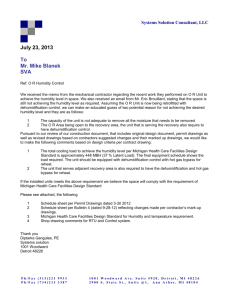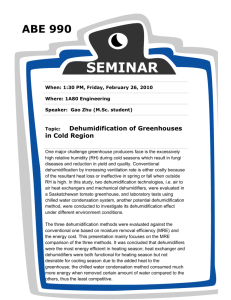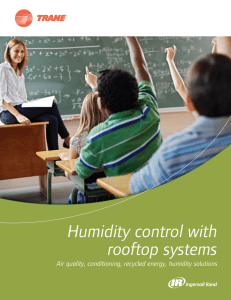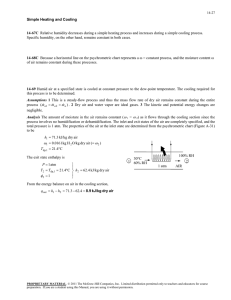Keys to Efficient Dehumidification
advertisement
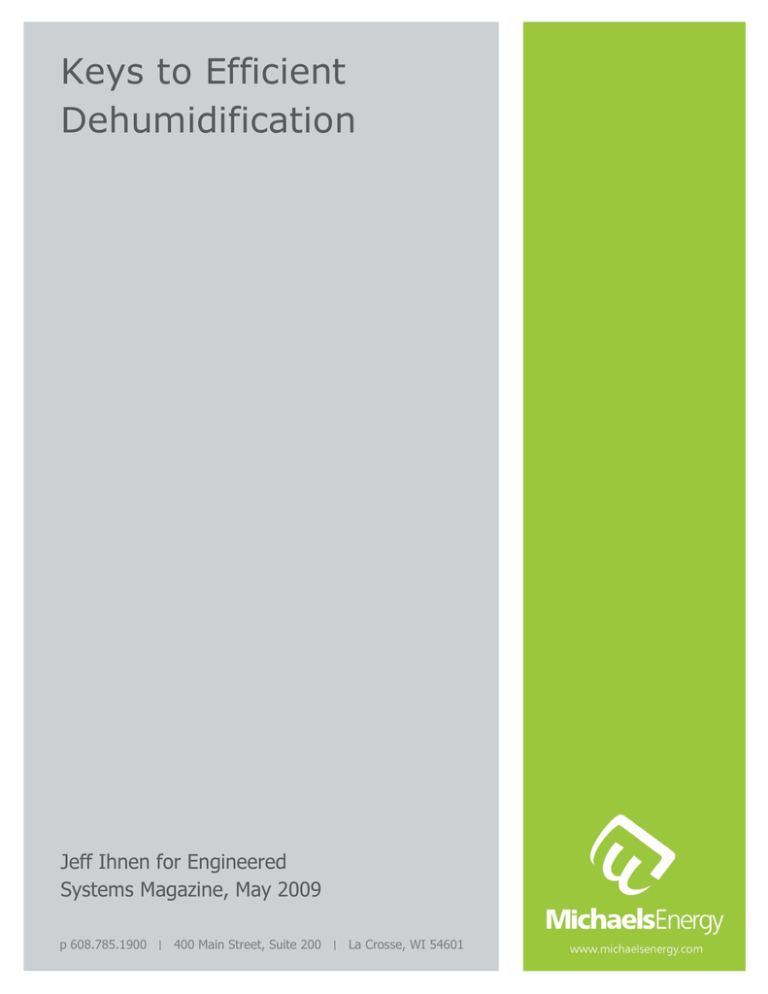
Keys to Efficient Dehumidification Jeff Ihnen for Engineered Systems Magazine, May 2009 p 608.785.1900 ∣ 400 Main Street, Suite 200 ∣ La Crosse, WI 54601 Contents Keys to efficient dehumidification ........................................................................................ 1 Relative Humidity: What is it? ............................................................................................. 2 Moisture Sources ............................................................................................................... 3 Reheat .............................................................................................................................. 4 Controls ............................................................................................................................ 5 Dehumidification Control Strategy #1: Only cool to the desired dew point when necessary .. 5 Dehumidification Control Strategy #2: Control cooling using variable volume to the maximum extent possible ............................................................................................................... 5 Dehumidification Control Strategy #3: Keep the building positively pressurized ................... 6 Dehumidification Controls Strategy #4: Shut down outside air when the building is unoccupied ..................................................................................................................... 6 Systems ............................................................................................................................ 8 Dehumidification System Design Strategy #1: Dedicated outdoor air systems ..................... 8 Dehumidification Control Strategy #5: Provide minimal temperature control with DOAS makeup air units ............................................................................................................. 9 Dehumidification System Design Strategy #2: Precool and reheat ventilation air with energy recovery ...........................................................................................................................10 Conclusion ........................................................................................................................11 Keys to Efficient Dehumidification Page | 2 Keys to efficient dehumidification The keys to efficient dehumidification include selecting the appropriate system for the application and controlling the system to minimize energy consumption. In most scenarios where excessive energy is wasted, it is not just the dehumidification process, but also the temperature control of the space that is performed inefficiently. This article focuses on dehumidification with mechanical cooling. Keys to Efficient Dehumidification Page | 1 Relative Humidity: What is it? Relative humidity (RH) is a function of both the moisture in the air and the air temperature. It is equal to the amount of moisture in the air relative to the amount of moisture the air could hold if it were 100% saturated (e.g., fog). Air that has a relative humidity of 50% has 50% of the moisture it can hold at that dry bulb temperature. Therefore, relative humidity can be lowered by either decreasing the moisture in the air, or raising the air temperature. Some terminology: • • • Dew point: the temperature at which air is saturated with moisture, at 100% relative humidity Dry bulb temperature: sensible temperature that a thermometer reads Wet bulb temperature: temperature of a wet surface that is evaporating in equilibrium with the surrounding air in an adiabatic process In most applications, increasing space temperature substantially is not an option. Ninety degree air at 50% relative humidity is very uncomfortable. People tend to declare that such conditions are “100% humidity”. Hardly. One hundred percent relative humidity means the dew point equals the air temperature. A dew point of 80F is very high and very rare. The “typical meteorological year” in Miami does not include dew points that high. So, we need to control moisture and temperature. Typical parameters include controlling space temperatures to 73-75 degrees Fahrenheit, and 50% relative humidity. It just so happens that air with a dew point of 55F and a dry bulb temperature of 75F has a relative humidity of almost exactly 50%. Many air handling systems with mechanical cooling (chilled water or direct expansion) are controlled to a discharge temperature of 55F or slightly lower. Keys to Efficient Dehumidification Page | 2 Moisture Sources For most commercial applications, outside air for ventilation and the building occupants are the primary sources of moisture. Consider: a typical occupant in a commercial building such as a school, office building, retail store, or healthcare facility, produces about as much heat as a 100 Watt light bulb. About 40% of this is in the form of moisture released to the space and the rest is sensible heat associated with temperature rise. A typical person will release about 0.14 lb of moisture per hour. A typical ventilation rate is 15 cubic feet per minute (CFM) per person. The moisture delivered by this flow of outside air is of course dependent on the outdoor air conditions. Figure 1 shows the moisture coming from the ventilation air generally required for each person, at varying, but typical outdoor air conditions in humid climates, which include states east of the Rocky Mountains. Moisture released by occupants may constitute about 50% or more of the total over the course of a cooling season. FIGURE 1 MOISTURE IN VENTILATION AIR 0.5 lbm/hr Added Moisture 0.4 0.3 0.2 Moisture From Occupant Moisture from Ventilation 0.1 Net 0 -0.1 47 52 57 62 67 72 77 82 87 92 97 102107 Degrees F Outdoor Temperature -0.2 Note also that ventilation air required for occupants isn’t necessarily the minimum air flow into the building. Often times in commercial buildings, the amount of makeup air required for exhaust for bathrooms or other spaces is greater than the ventilation air required for good air quality for occupants. Keys to Efficient Dehumidification Page | 3 Reheat Dehumidification via mechanical cooling occurs by driving the conditioned air temperature down to the desired dew point. When too much air at the desired dew point temperature is supplied to a space, the air must be reheated to maintain desired conditions. If the target is 50% RH, the space must be about 74-75F if the air handling system is reducing air moisture to a 55F dew point. Air at 70F with a 55F dew point is out of range at 59% RH, “clammy”, and not acceptable. This is also close to 60% RH, which presents potential for mold growth. Heat from building envelope gains, internal gains, and/or energy sources like natural gas or electric resistance is needed. Minimizing reheat energy is often the difference between an efficient system and an energy hog. Keys to Efficient Dehumidification Page | 4 Controls As with any energy intensive system or process, controls are critical to efficient operation. This section provides control strategies to minimize energy consumption associated with dehumidification. Dehumidification Control Strategy #1: desired dew point when necessary Only cool to the On occasion when space relative humidity must be controlled for comfort, manufacturing, or material preservation such as in libraries and museums, air handler discharge temperature is set to maintain a constant temperature that equals the dew point temperature associated with the desired RH. This can waste energy from unnecessary mechanical cooling, reheat, or both. Air handler discharge should be reset as high as possible to maintain temperature in the warmest zone served, with an override for humidity control. Return air RH is typically monitored, or in the case of 100% outside air units, the indoor sensors are monitored. Once the RH setpoint is exceeded, the system goes into dehumidification. Dehumidification Control Strategy #2: Control cooling using variable volume to the maximum extent possible Most energy codes (International Energy Conservation Code 2006) require that variable air volume systems be capable of reducing air flow to 0.4 CFM per square foot, or 30% of design flow, or ASHRAE Standard 621 ventilation levels, whichever is less. In many existing buildings the minimum flow, or minimum variable air volume box position is higher than some or all of these metrics. Sensible cooling delivered to a space is proportional to the product of difference in space temperature and supply temperature, and air flow: Q ∝ (TSpace − TSupply ) ⋅ cfm When cooling delivered by the supply air is greater than the load, the supply temperature must rise or the CFM must be decreased. If flow is not low enough while maintaining a desired dew point temperature, reheat is required. Therefore, the minimum flow should be set by ASHRAE Standard 62, which covers both minimum ventilation levels for occupied spaces and exhaust for restrooms. One way to accomplish this is to incorporate occupancy sensor control in series with CO2 demand-controlled ventilation. When a space is unoccupied, the minimum box position is set to 1 Ventilation for Acceptable Indoor Air Quality Keys to Efficient Dehumidification Page | 5 0 CFM. During normal business hours, the VAV box only controls temperature when these spaces are unoccupied. As the space becomes occupied, the box will open to the minimum required for the area component of ASHRAE Standard 62. As CO2 rises indicating a greater rate of occupant pollutant production, the minimum box position increases. In many cases, total system air flow can be reduced to almost as low as the required exhaust flow, essentially turning air handling systems into 100% outside air units. Minimizing flow minimizes dehumidification energy both for cooling and any reheat, as well as fan energy. Systems that are constant volume, such as dual duct, multi-zone, or constant volume reheat are likely to be near the end of their expected life and should be converted to variable air volume. Many times, this can be done by installing VAV boxes and new digital controls, with little ductwork modifications and relatively minor air handler upgrades. In many cases, spaces that require significant exhaust including laboratories, kitchens, and locker rooms have their own dedicated makeup air units. These units are typically single zone but they should also have variable volume capability. Single zone systems are good candidates for variable air volume and they convert easily with a variable frequency drive. Temperature is controlled first by heating or cooling valve position, and then fan speed. This again minimizes cooling, reheat, and fan energy. Control sequences may need to be modified to provide better space air mixing if stratification becomes a problem, especially during the heating season, or if “dumping” occurs in cooling mode. Dehumidification Control Strategy #3: Keep the building positively pressurized When exhaust flow is greater than makeup air supplied, buildings are negatively pressurized, and numerous problems can occur, including temperature and humidity control problems, as untreated air is drawn into the building. If a building is negatively pressurized overnight when most air handling systems are in unoccupied mode, there is a risk of freezing coils in air handlers or pipes in plenum spaces in northern climates. Dehumidification Controls Strategy #4: outside air when the building is unoccupied Shut down This may sound like a no-brainer, but sometimes air conditioning is used in attempt to dry out a building when a space is unoccupied. School or university buildings that have floors waxed or carpet shampooed are good examples. The systems are placed in occupied mode to drive the temperature down in attempt to dry the spaces. The problem with this is the source of moisture from outdoors is not shut down and typically these buildings are not running boilers for reheat, and there are no internal heat gains from lighting, equipment, or people to provide a load for sensible cooling. As a result, air conditioning coils are either running at relatively high temperature in the case of systems with chilled water, or direct expansion coils are cycling on and off, or using hot gas bypass to artificially load the unit. In either case moisture is not being Keys to Efficient Dehumidification Page | 6 extracted to drive down the dew point and in the case of hot gas bypass, the unit is wasting compressor energy. With relatively high dew point temperatures that approach space dry-bulb temperature, the building gets clammy as described above. The dew point of the air in the building tracks the outside air dew point. In some cases space temperatures are set lower to dry the air. This is actually increases relative humidity in many cases. One strategy for drying out a building is to let nature provide reheat via skin heat gains. Again higher temperatures tend to decrease relative humidity but in this case it also increases evaporation from the building materials. Increased evaporation of course tends to increase RH. Condition the air to the desired dew point periodically during the day and let the building reheat on its own. Of course this works best during hot weather that provides the most “reheat”. Keys to Efficient Dehumidification Page | 7 Systems Another strategy for minimizing dehumidification energy is to select equipment and design air handling systems to provide built-in energy efficiency. Dehumidification System Design Strategy #1: Dedicated outdoor air systems Dedicated outdoor air systems (DOAS) treat outdoor air independently from zone temperature control. The makeup air unit in the DOAS provides pre-treated ventilation to the temperature control zones. In the cooling season, dehumidification takes place in the DOAS. Zone temperature control is provided by fan coil units, heat pumps, or chilled beams and some type of zone heat such as fin-tube convection systems or radiant heat. The advantage to this design, when controlled effectively, is that it can minimize or eliminate the need for reheat. However, the key word in the previous sentence is can. Often times the makeup air unit serving the DOAS is controlled to provide temperature-neutral air (70F) all year. This is a mistake and wastes energy most of the time in typical DOASs. Heating air to above 55F in the winter or reheating to above 55F after dehumidifying outdoor air in the summer often results in unnecessary simultaneous heating and cooling. For example, ventilation air may be driven down to maintain space relative humidity and the air is then reheated to a neutral 70F. This air then makes its way to mix with return air and in many cases must be cooled at the zone to maintain space temperature set points. Even if the reheat is free from some sort of heat recovery, unnecessary cooling energy is consumed at the zone. Figure 2 demonstrates wasted reheat and re-cooling associated with a DOAS makeup air unit with downstream cooling. FIGURE 2 DOAS WITH REHEAT AND DOWNSTREAM COOLING Keys to Efficient Dehumidification Page | 8 Dehumidification Control Strategy #5: Provide minimal temperature control with DOAS makeup air units In the heating season, outdoor air should be heated to no more than 55F. In some cases, maintaining an even lower temperature saves energy by providing more free cooling to zones that need it, although drafts and condensation on ductwork in the building must be avoided. When dehumidification is required, drive the outdoor air temperature down to maintain desired relative humidity and leave it there. Typically, when dehumidification is required, more zones being served by the DOAS require cooling rather than heating. If heat recovery from the condenser of the makeup air unit or some other free heat source is available, AND the building automation system maintains status of heating and cooling in each zone, the discharge air temperature on the makeup air unit may be reset to minimize energy consumption. However, this is a complicated algorithm and it really only applies during light cooling loads. During periods of greater cooling loads, 55F air from the makeup air unit is not wasted because as it is typically mixed with 70-90% return air, providing little cooling for the space. In other words, there is no overcooling and reheat. Keys to Efficient Dehumidification Page | 9 Dehumidification System Design Strategy #2: Precool and reheat ventilation air with energy recovery In some facilities such as laboratories, the need for makeup air is so great that reheat cannot be avoided. In these systems an energy recovery unit with pre cooling and reheating provided by energy recovery is a low energy-cost option. In dehumidification, outdoor air is precooled by exhaust air. The fresh air is then cooled to the desired dew point with mechanical cooling and then reheated again by the exhaust air. The exhaust air that gives up heat to the fresh air discharge is cooled in preparation to extract heat from the incoming ventilation air. Dry tempered air is delivered to the zones that are again conditioned using fan coil units, heat pumps, or chilled beams with some other source of heating. Figure 3 provides a line diagram of an energy recovery unit that can be used for dehumidification. Air enters at 93F, 51% RH, and a dew point of 72F. It is dehumidified to a dew point of 54F with a 65% reduction in cooling energy and 100% reduction in reheat. Note however, that even at 67F, large amounts of this cool dry air provides substantial space cooling, and therefore some reheat may be inevitable. FIGURE 3 DOAS WITH ENERGY RECOVERY 2 2 Image courtesy of Laboratories for the 21st Century, U.S. Environmental Protection Agency Keys to Efficient Dehumidification Page | 10 Conclusion As with any energy-consuming system, system control is the number one key to “efficient” dehumidification. System design is second, because even if a great system for the application is built, wasteful control sequences can throw it all out the window. On average, cooling and heating source efficiency has only a small fraction of the impact that controls and system design have. Keys to Efficient Dehumidification Page | 11

